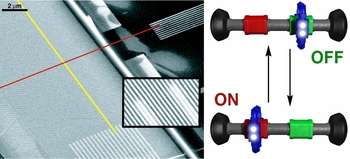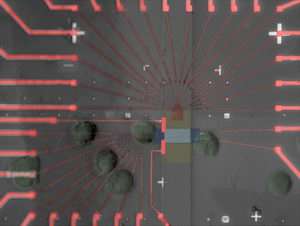Toward Building Molecular Computers

Don't throw away your laptop yet, but there's a promising new high-tech invention being announced this week. Researchers have created a memory circuit the size of a white blood cell that has enough capacity to store the Declaration of Independence and have space left over. With 160 kilobits of capacity, it's the densest memory circuit ever fabricated.
A team of UCLA and California Institute of Technology chemists reports in the Jan. 25 issue of the journal Nature the successful demonstration of a large-scale, "ultra-dense" memory device that stores information using reconfigurable molecular switches. This research represents an important step toward the creation of molecular computers that are much smaller and could be more powerful than today’s silicon-based computers.
The 160-kilobit memory device uses interlocked molecules manufactured in the UCLA laboratory of J. Fraser Stoddart, director of the California NanoSystems Institute (CNSI), who holds UCLA’s Fred Kavli Chair in Nanosystems Sciences and who was awarded a knighthood by Queen Elizabeth II less than a month ago.

A bit, or binary digit, is the basic unit of information storage and communication in digital computing. A kilobit is equal to 1,000 bits and is commonly used for measuring the amount of data that is transferred in one second between two telecommunication points.
The research published in Nature describes the fabrication and operation of a memory device. The memory is based on a series of perpendicular, crossing nanowires, similar to a tic-tac-toe board, with 400 bottom wires and another 400 crossing top wires. Sitting at each crossing of the tic-tac-toe structure and serving as the storage element are approximately 300 bistable rotaxane molecules. These molecules may be switched between two different states, and each junction of a crossbar can be addressed individually by controlling the voltages applied to the appropriate top and bottom crossing wires, forming a bit at each nanowire crossing.
The 160-kilobit molecular memory was fabricated at a density of 100,000,000,000 (1011) bits per square centimeter — "a density predicted for commercial memory devices in approximately 2020," Stoddart said.
A rotaxane is a molecule in which a dumbbell-shaped component, made up of a rod section and terminated by two stoppers, is encircled by a ring. It has the potential to be a molecular abacus. The bistable rotaxanes behave as switches by incorporating two different recognition sites for the ring, and the ring sits preferentially at one of the two, said Stoddart, leader of the UCLA team. The molecule can act as a switch provided the ring can be induced to move from one site to the other site and then reside there for many minutes. The bistable rotaxane molecules used in the crossbar memory can be switched at very modest voltages from an "off" (low conductivity) to an "on" (high conductivity) state. The stoppers for the rotaxane molecules are designed to allow the molecules to be organized into single-molecule-thick layers, after which they are incorporated into the memory device, Stoddart said.
"Fraser Stoddart is the ‘Maestro of Molecules,’ " said Patricia O'Brien, executive dean of UCLA’s College of Letters and Science. "This is highly significant research."
"For this commercial dream to be realized, many fundamental challenges of nano-fabrication must be solved first," Stoddart said. "The use of bistable molecules as the unit of information storage promises scalability to this density and beyond. However, there remain many questions as to how these memory devices will work over a prolonged period of time. This research is an initial step toward answering some of those questions.
"Using molecular components for memory or computation or to replace other electronic components holds tremendous promise," Stoddart said. "This research is the best example — indeed one of the only examples — of building large molecular memory in a chip at an extremely high density, testing it and working in an architecture that is practical, where it is obvious how information can be written and read.
"We have shown that if a wire is broken or misaligned, the unaffected bits still function effectively; thus, this architecture is a great example of ‘defect tolerance,’ which is a fundamental issue in both nanoscience and in solving problems of the semiconductor industry. This research is the culmination of a long-standing dream that these bistable rotaxane molecules could be used for information storage," said Stoddart, whose areas of expertise include nanoelectronics, mechanically interlocked molecules, molecular machines, molecular nanotechnology, self-assembly processes and molecular recognition, among many other fields of chemistry.
"Our goal here was not to demonstrate a robust technology; the memory circuit we have reported on is hardly that," said James R. Heath, Caltech’s Elizabeth W. Gilloon Professor of Chemistry and a co-author of the Nature paper. "Instead, our goal was to demonstrate that large-scale, working electronic circuits could be constructed at a density that is well-beyond — 10 to 15 years — where many of the most optimistic projections say is possible."
Caltech chemists and chemical engineers, led by Heath, are the world leaders at making nanowires, according to Stoddart. "Nobody can equal them in terms of the precision with which they carry this research out," he said. The memory device’s top and bottom nanowires, each 16 nanometers wide, were fabricated using a method developed by Heath’s group.
Stoddart’s research team is widely considered the world’s leader in making molecular switches, an area in which Stoddart and his colleagues have conducted 25 years of research that has laid the foundation for this current work. Stoddart’s group designs and manufactures intricate interlocked molecules in which the relative motions of the interlocked components can be switched in controlled ways.
Stoddart and Heath are pioneers in molecular electronics — using nanoscale molecules as key components in computers and other electronic devices. Stoddart harnesses molecular self-assembly in sophisticated ways, designing molecules that can be made by "templation methods" and that orient themselves such that they can be incorporated into solid-state devices in predictable ways.
A variety of molecular electronic components have been demonstrated, said Stoddart, lead authors Jonathan E. Green and Jang Wook Choi of Heath’s Caltech laboratory, and Heath, who is a member of CNSI’s scientific board. For example, logic gates, memory circuits, sensors and many other fundamental components have been reported.
"However, few of these components have been demonstrated to work in practical, highly dense device arrays before," Stoddart said.
"One of the most exciting features of this research is that it moves beyond the testing of molecular electronic components in individual, non-scalable device formats and demonstrates a large, integrated array of working molecular devices," said William R. Dichtel, a researcher who is a member of both Stoddart’s and Heath’s research teams. "In targeting a large memory array, many fundamental issues of how information is stored and retrieved had to be addressed."
While this research could affect the computer industry dramatically, it also may have a significant impact on very different uses of information technologies as well, said Heath and Stoddart, whose research is funded primarliy by the Defense Advanced Research Projects Agency, the central research and development organization for the U.S. Department of Defense, with additional funding by the National Science Foundation.
"Molecular switches will lead to other new technologies beyond molecular electronic computers." Stoddart said. "It is too soon to say precisely which ones will be the first to benefit, but they could include areas such as health care, alternative energy and homeland security.
"In 1959, physicist Richard Feynman said it should be possible some day to store all of the Encyclopedia Britannica on the tip of a needle," Stoddart noted. "We’re not there yet, but we’re not far off."
The CNSI, a joint enterprise between UCLA and the University of California, Santa Barbara, is exploring the power and potential of organizing and manipulating matter to engineer "new integrated and emergent systems and devices, by starting down at the nanoscale level, that will aid and abet information technology, energy production, storage and saving, environmental well-being, and the diagnosis, prevention and treatment of chronic and degenerative diseases with an impact that far outstretches our comprehension of life to date," Stoddart said.
Nanosystems-related research is performed on a size-scale ranging from 1 nanometer — about one-billionth of a meter — to a few hundred nanometers. The DNA molecule is 2 nanometers wide, roughly 1,000 times smaller than a red blood cell and 10,000 times smaller than the diameter of a human hair.
Source: University of California - Los Angeles, Caltech





















